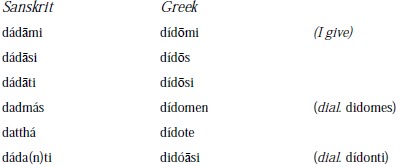The most important discovery leading to this hypothesis was the recognition that Sanskrit, a language of ancient India, was one of the languages of the group. This was first suggested in the latter part of the eighteenth century and fully established by the beginning of the nineteenth.1 The extensive literature of India, reaching back further than that of any of the European languages, preserves features of the common language much older than most of those of Greek or Latin or German. It is easier, for example, to see the resemblance between the English word brother and the Sanskrit bhrātar-than between brother and frāter. But what is even more important, Sanskrit preserves an unusually full system of declensions and conjugations by which it became clear that the inflections of
these languages could likewise be traced to a common origin. Compare the following forms of the verb to be:
these languages could likewise be traced to a common origin. Compare the following forms of the verb to be:
The material offered by Sanskrit for comparison with the other languages of the group, both in matters of vocabulary and inflection, was thus of the greatest importance. When we add that Hindu grammarians had already gone far in the analysis of the language, had recognized the roots, classified the formative elements, and worked out the rules according to which certain sound-changes occurred, we shall appreciate the extent to which the discovery of Sanskrit contributed to the recognition and determination of the relation that exists among the languages to which it was allied.

























0 komentar:
Posting Komentar